|
|
|
||||
|
|
|
||||
|
The Spawning Pictorial As people have often asked about what the spawning process looks like, or how we handle our Bettas' procreational attempts, we have put up a page that should hopefully answer these questions. As with anything seen on this Website, if you have any questions, please feel free to contact us. The Introduction...  When a male has been alone in the spawning tank, he should build a sufficient nest for the sole purpose of rearing fry. This, of course, is assuming that he truly is mature enough to spawn and that he has no health difficulties which would curtail interest. Once this has been built, we place the selected female in a glass container already in the spawning tank. Whether it be an open-topped quart jar, or a hurricane lamp's globe, it serves to temporarily house the female during the "look, but don't touch" phase of courtship. There will be the typical flaring (perhaps by both), some charging, and just excitement in general. You may even notice that the female's horizontal stripes of fear will change to the vertical stripes of welcome! In this case however, our female never warmed to our male and she was substitued for the female seen in photos two and three. If you look at this photo very closely, you can still see traces of horizontal striping.  Though blurry, this photo shows clear acceptance by both partners and it was at this point that the female was released. The pair must be kept under constant supervision during this touching phase as aggression may break out at any moment. While some nipping is almost to be expected, it is up to you to draw the line at just the right time if, in fact, one needs to be drawn. If it must, place the female back in her safety glass for a time and attempt a reintroduction later. On the other end of the spectrum, and this is more likely with experienced pairs, the Bettas may know just what they are there for and will get to spawning within the hour. Normally though, it takes up to three days to get our pairs to do what they are there to do and proceed without so much as a fin nip. 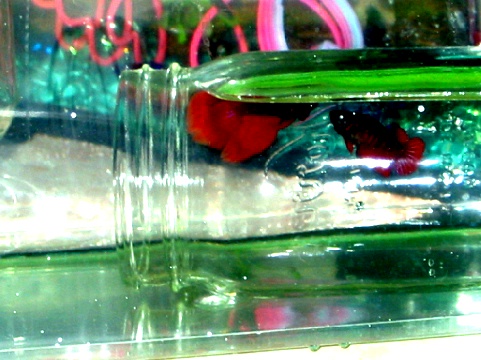 If a quart jar was used (we prefer to use them because of the reason listed here), we turn it onto it's side and trap some air inside. The smart male will build a new nest inside of the jar...less distance to swim for collecting fallen eggs and fry! Even if the male does not use the jar for this purpose, it can serve it's original: a "safe" zone in case things get a little out of hand. Between the jar and plants put in for the sake of providing hiding spots, we rarely need to remove a female. The Act of Spawning 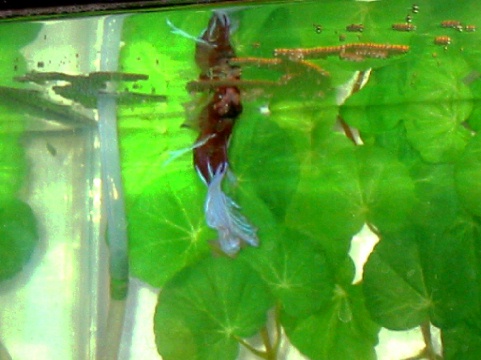 Using photos of a different pair, this set will show you the entire spawning act. Please bear in mind that the "embrace" and collections shall be repeated many times and will only end when either the female runs out of ova or, the male is tired out and calls it quits. It is not uncommon for us to have a pair cohabitate for up to 12 hours! In this photo, you see a red/white BF ST male preparing the nest that will soon hold his progeny. For reference, the female was already released and he is coercing her to join him under the "nursery". 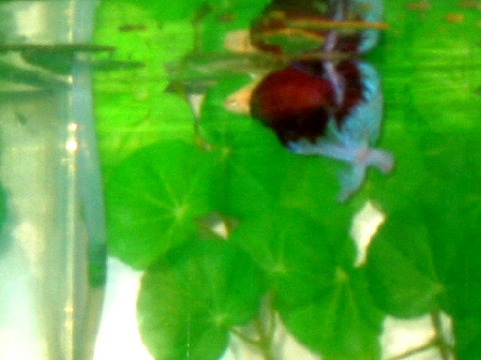 It worked! The yellow DT female has joined him under the nest and gave him the seal of approval. If she did not like his nest, she would have torn it down and forced him to start over. Fortunately, this was not the case and you can see the male trying to effect an embrace. 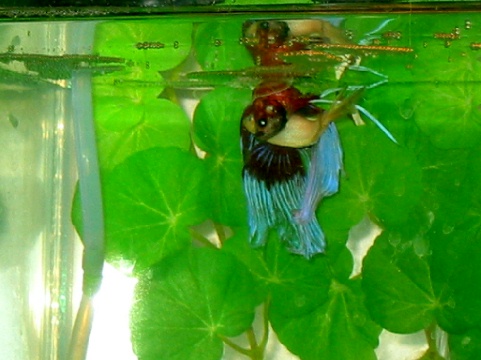 After swimming over her back, he wraps his body around hers while simultanesously turning her upside down. There may be several practice runs, or they may get it right the first time. Once you notice miniscule white dots falling, you know that they have it figured out! It is during each egg batch's release that the eggs are fertilized. 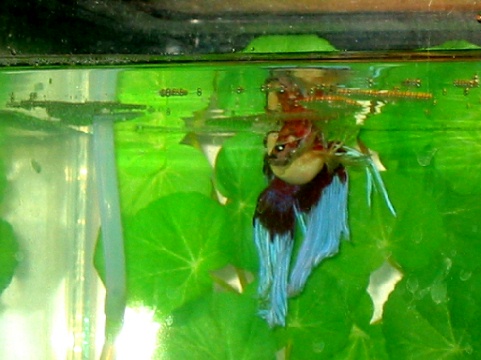 While this pair never once sank to the bottom during any of their embraces, prepare for the fact that some will go down. Both are considered completely normal. 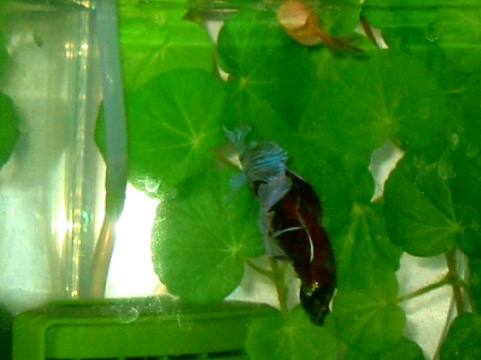 The appearance of the female directly following an embrace is the part that surprises most new breeders. For all practical purposes, she appears dead! Actually, she is alive and well, simply stunned by the male's hormonal release. This is a temporary condition that can last anywhere from 30-60 seconds and on rare occasion, you may find that the male stuns himself in the process. For most males, this is the time to dive for collection of the released ova. Dad will swoop down to grab as many as he possibly can and will take as many trips as is necessary. This is also the time when fathers can be classed into one of three categories: 1. The Fantastic Father 2. The Mediocre Father 3. The Undesirable Father MEMBERS OF: Global Half Moon Breeders Club
|
 | ||
 About Us | Contact Us | 2002 Projects | Gallery | Stock Shoppe About Us | Contact Us | 2002 Projects | Gallery | Stock Shoppe  Current Spawns | Home  | |||